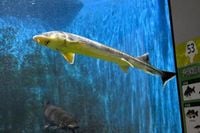In a surprising turn of events, a shovelnose sturgeon, a species native to the Pacific coast of North America, was caught in Lake Shinji, located in the eastern part of Shimane Prefecture, Japan. This unique catch has sparked curiosity among local officials and fish enthusiasts alike, as it is believed to be the first time such a fish has been found in this area.
The sturgeon, which measures approximately one meter in length and boasts a dark coloration, was captured on March 1, 2025, by a fisherman using a gill net near Ohno-cho, Matsue City, situated north of Lake Shinji. After its capture, the fish was transported to the Shimane Prefectural Lake Shinji Nature Center, known as Gobiusu, where it underwent treatment for its injuries.
According to Seiji Teraoka, a representative from Gobiusu, the sturgeon was confirmed to be a shovelnose sturgeon after a photograph was sent to a specialist in fish taxonomy. Teraoka stated, "It is likely that this fish had been raised in captivity, as it began to eat bait shortly after arriving at the facility." This behavior indicates that the sturgeon may have been previously domesticated, raising questions about how it ended up in Lake Shinji.
The exhibition of the sturgeon began on April 25, 2025, and has attracted attention from visitors eager to learn more about this ancient species. The shovelnose sturgeon is often referred to as a living fossil, having remained largely unchanged in form since the Jurassic period. This remarkable fish is not only significant for its historical value but also for its culinary connection; the eggs of the sturgeon are processed into high-quality caviar, a delicacy in many parts of the world.
While the presence of the sturgeon in Lake Shinji raises intriguing questions, Teraoka noted that the exact circumstances surrounding its arrival remain uncertain. "There is a possibility that someone released a privately owned fish into the lake," he remarked, adding, "However, we have no means to investigate this further." Interestingly, no sturgeon farming facilities have been identified in the vicinity of Lake Shinji, which adds another layer of mystery to the situation.
The incident has prompted discussions about the ecological implications of such exotic species appearing in local waters. Experts warn that the introduction of non-native species can disrupt local ecosystems, potentially outcompeting native species for resources and altering the balance of the aquatic environment.
As the exhibition continues, Gobiusu is offering free admission to junior high school students and younger visitors until May 11, 2025. This initiative aims to encourage young people to explore and appreciate the natural environment, particularly during the Golden Week holiday, a popular travel period in Japan.
Given the sturgeon's unusual appearance in Lake Shinji, many are left wondering about the broader implications for local wildlife and conservation efforts. Teraoka urges visitors to reflect on the significance of this ancient fish, stating, "It is important to consider whether this fish is a natural occurrence or a result of human activity. We hope people will engage with this topic and think about the natural world around them."
As the exhibition progresses, the story of the shovelnose sturgeon continues to unfold, captivating the interest of both locals and tourists alike. With its prehistoric lineage and mysterious arrival, this fish serves as a reminder of the complex relationships between humans and nature, as well as the importance of preserving the delicate balance of ecosystems.
In conclusion, the capture and display of the shovelnose sturgeon at the Gobiusu center not only highlights a rare occurrence but also opens the door for further discussions about environmental stewardship and the impact of human actions on wildlife. As visitors flock to see this remarkable fish, they are invited to ponder the questions it raises and consider their role in protecting the natural world.

